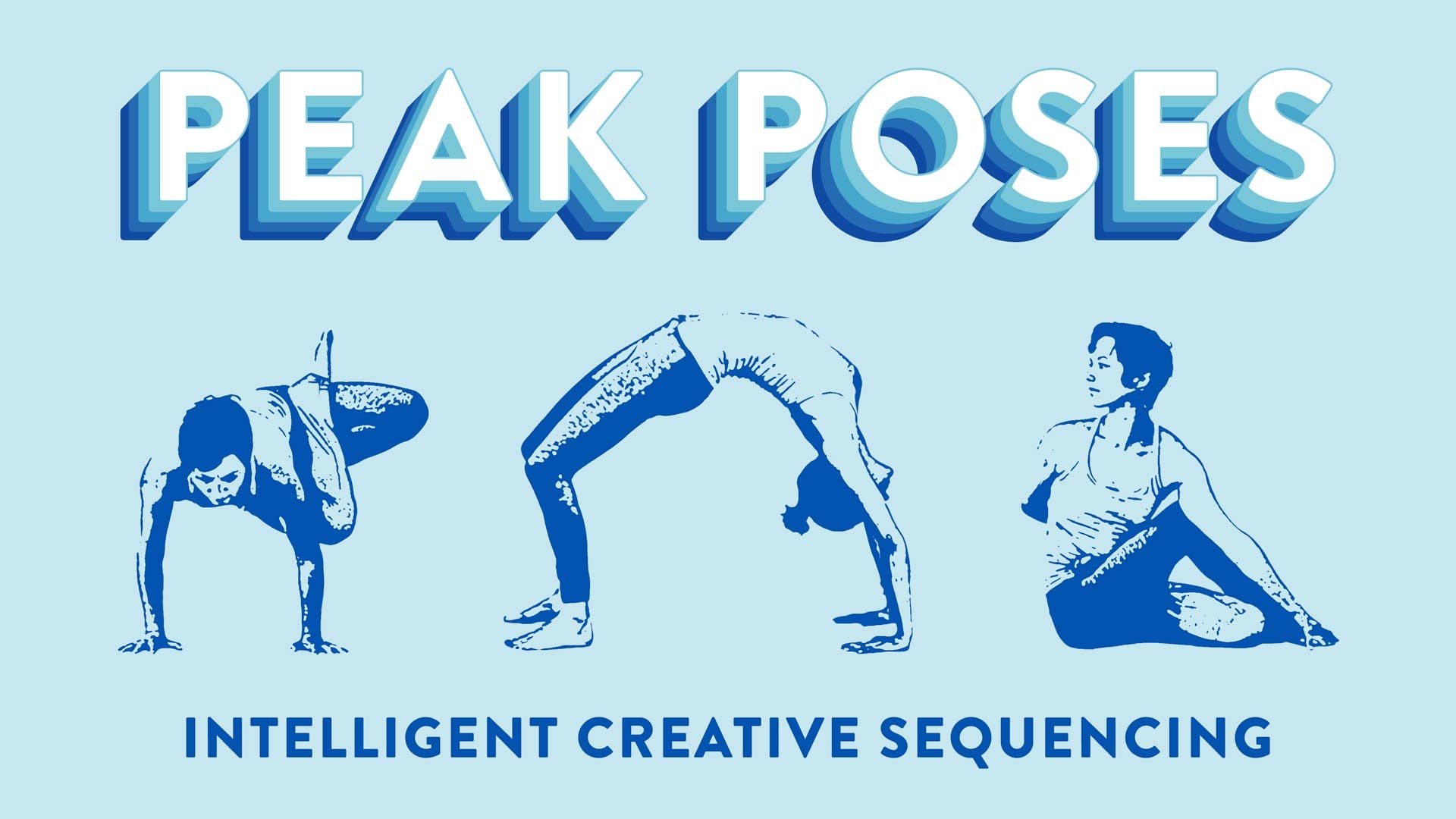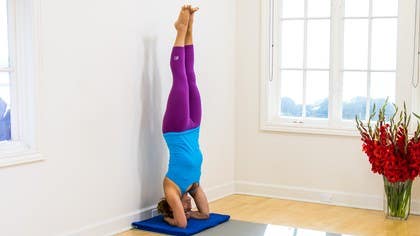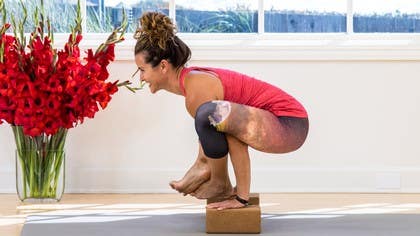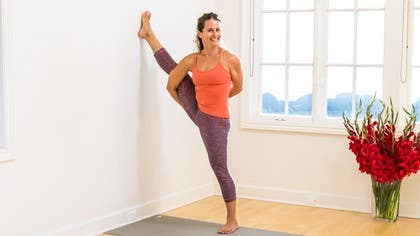Description
About This Video
Transcript
Read Full Transcript
Greetings tribe, thanks for joining me. This is going to be a shorter practice sequencing towards a couple of variations of headstands, your sassana. So you might want to set up near the wall and also if you have a couple of blocks and a blanket for padding, that would be great. Let's get started. So come into child's pose to start and you can take your knees a little bit wide and then just drop down into a comfortable child's pose here.
Do allow your forehead to make contact with something. If it's not your mat, then you can put a block or a folded blanket under your forehead and just let go of all effort and let yourself really connect and drop down into the earth. So that connection of your forehead, your third eye, down through the mat, through the floor into the soil and just start to shift a little bit from side to side, rolling across the forehead, letting the hips shift a little bit. Begin to deepen your breath. Allow some free movement through the neck, through the cervical spine, almost like there's a bit of a tassel-like movement, rebounding and referring down your spine from the crown to your hips and just starting to really get familiar with these different surfaces that are in contact with the floor, from the shins, the knees, the forehead, your forearms, your hands.
And just getting comfortable here, coming back to center and as you inhale, just lightly glide forward to your shins, your forearms and roll to the crown of your head, very little weight there, just a gentle stretch for the back and the neck. And then as you exhale, relaxing back towards the forehead, the tip of the nose. Once again, inhale, just rolling, feeling that pathway from your third eye to your crown and then back again, super simple, inhaling, connecting and finding that sweet spot right at the center of the crown and exhaling to release back down. And the next time you roll forward onto your crown, pause there for a moment and just slip the left arm underneath you and then release back and down and allow the weight of your shoulders to gently release through the outer left shoulder and the back of the heart. Deep breath in here.
As you exhale, you can just slide the right hand down towards the left arm and just roll a little bit towards the left side, back and forth, transitioning a little bit of weight from the center of the forehead to the side of the head and the outer shoulder and a couple of things that we want to really prepare as we work towards headstand is opening both the hamstrings and also the shoulders. And so just this very subtle work using our body weight helps to start to breathe a little more openness through the shoulders. And then making your way back through center and just changing sides, releasing the right arm underneath and dropping right back down to the center of the forehead and really allowing gravity to help you here and to drop down, opening up, feeling the right side of the heart and the outer right shoulder and sliding your left hand in and once again just kind of rocking in and out from the center of the forehead to the side of your head and getting to know these different surfaces as you roll across the temple and then back down through the center. Inhaling to open, exhaling to come back down and once more, inhaling to open and exhaling to come back down and to center, walking your hands forward and let's go ahead and inhale to the hands and knees, set up your hands underneath your shoulders, curl your toes under and press back to downward facing dog. So from your downward facing dog we'll start to move through some simple patterns to just open up the hamstrings.
Take a deep breath in as you reach the right leg back and up and then exhale, step all the way through to a low lunge, lower the back knee down. As you exhale, shift back into an Ardahana Manasana and then shift forward into your lunge and just really simple inhaling to lift the heart and exhaling to shift back, inhaling to lift through the heart and exhaling to shift back. Once more, inhaling, shifting forward and exhaling to shift back and down and then making your way back to downward facing dog and we'll go right to the second side. Taking the left leg to the sky on an inhale, exhale, step all the way through, coming to your low lunge, lifting the heart as you inhale and then exhaling to glide back and down. As you shift forward and back, if the floor feels a little far away you can always take your blocks and just place them right underneath your hands but keep a little bit of fluid movement here.
Just invite some opening not only into the hamstring but also the back of the neck and as you shift forward, front of the hip and heart. Once more, shifting forward to your runner's lunge, exhale back to downward facing dog. Inhale the right leg to the sky, exhale, step it through the same pattern just a little bit different. We can keep the back knee lifted as you reach your chest forward and then exhale, shifting back and if you can, pick up the front toes and release your head down. Inhale, shift forward to a runner's lunge, exhale, shifting back and it's a variation of pyramid pose, parsvottanasana.
Reach forward on an inhale and exhale, opening and releasing through the back of the knee. Shift forward to your runner's lunge, press back to downward facing dog. Now the left leg to the sky, exhale, step all the way through to your high lunge and then shifting back, opening up through the back of the leg, back of the neck. Inhale to reach forward, exhale, opening twice more. Inhale to reach forward and exhale, straighten the front leg and the amount.
Once more, inhale to shift forward, exhale, press back to downward facing dog. From here, lower down to your knees and then lower down to your forearms and lace your fingers and let's just take a moment here to experience a little bit of movement in our shoulder girdle. So notice that you can sink the heart down and you can also kind of puff up through the back of the heart and spread the shoulder blades. So just take that range of motion a couple times, massaging through your shoulders, feeling that ability to move the spine through the gates of the shoulders down into gravity and away from it. And we work with that same ability when we're inverted in our headstand, the ability to kind of sink or lift to depress or lift upwards through the shoulders.
So just feel that for a moment here without the complexity of the inversion, the ability to move through your shoulder girdle. And then as you're ready, just come back into your downward facing dog. From your downward facing dog, we'll just come into one simple standing sequence and let's actually take the left leg first this time. So as you inhale, sweep the left leg back and up. And as you exhale, step forward into a warrior one base, coming up to your Virabhadrasana one.
And as you exhale, go ahead and just take the right hand to the nape of the neck and the left hand to the tip of the elbow and draw your upper arm a little bit further behind your ear. Because this shape is the same shape that we come into in headstand in Suresasana A. So we want to start preparing our shoulders and opening up the chest to be able to support the position. So from here, straighten your front leg and let's actually pivot the feet for Prasarita Padottanasana. And you're welcome to keep your hand at the tip of the elbow or if you'd like, release your left hand behind your back and link up with your fingers or a strap.
Lift through the heart on an inhale. And as you exhale, come down into your forward fold. Tip of the elbow towards the earth and allow yourself a little bit of movement here. Shift the hips a bit side to side. Notice that you can slightly shrug the shoulders up or down, relax your head and neck and just hang out for a moment or two, breathing deeply.
With each inhale, get a little bit of length in the spine and with each exhale, dropping in and down any amount. Little bit of length as you inhale and exhale, drop in and down any amount and then release your hands, lift your chest on an inhale. As you exhale, walk your hands to your right and step back to downward facing dog. Take your right leg to the sky, we'll come into the second side. Inhale step all the way through to a warrior wind base, setting up your back foot and then inhale to rise.
Exhale, left hand comes to the nape of the neck and just adjust from the tip of the elbow to bring that upper arm a little further back behind the head. As you inhale, straighten the front leg, pivot the right toes in and then set yourself up for the second side, maybe reach behind your back. Open the chest as you inhale and then exhale into your forward fold. And again, I love this particular asana as a preparation for headstand because not only is it addressing the openness that we need to cultivate in the shoulders but also the openness in the hamstring and we start to feel this relationship of connecting the crown of the head towards the earth and depending on how long your arms are, your elbow might touch first, but just feel that length on the inhale and as you exhale, the dropping in and down. Lengthen on the inhales, almost imperceptible pulsation, exhale dropping in and down.
From here, stay low, release your arms and set up your hands for prasarita padottanasana A. So if we imagine a long line between our feet, we place our hands along that imaginary line and inhale, reach the chest forward. As you exhale, bend your elbows and draw the crown of the head down towards the mat, maybe on the mat and from here we see that first base of sarsasana B, headstand B. So feeling that right angle and the potential to tip a little bit of weight from your feet towards the crown of the head. So if you lift the heels up, maybe a quarter inch and then release them back down. And again, lifting the heels up just a tiny bit, starting to feel that potential for transitioning your weight from the feet into the crown of the head. And then release the heels back down as you inhale, lift the chest, walk your hands forward and now walk your hands towards the back of your mat, towards the wall and step back to downward facing dog.
We'll take a couple more preps here before we start to work into the actual practice of headstand. So from your down dog, go ahead and walk your feet towards your hands. And if you have your blocks nearby, you can take them and just place them right at the wall. And we'll come into a supported forward fold at the wall, can tuck your chin into your chest and bring your upper back, the back of your heart to the wall and lower the crown of your head down onto the box and just feel that connection once again. Notice that you have the ability here to press into your hands to lift the weight off of your head or to release completely.
Two blocks might feel just right, or you might feel like you can go a little deeper. And so you take one block off and come down, sliding a little further up the spine and taking the crown of the head down a little further. And again, we're just preparing by opening up the hamstrings and starting to feel that connection of the crown of the head into the earth. Take a deep breath in here. Slow exhale.
And then gently press your palms into the mat, ease yourself up off the block and set it to one side. Take your way back to downward facing dog. From your downward facing dog, set your knees lightly on the mat, walk your hands back to your knees and sit up tall in Virasana and take a moment here. So let's start to look at some different ways of getting into headstand at the wall. I like to use a blanket for headstand because I have a very hard head.
So this provides a little bit of extra padding, so you can take a blanket to the wall if you like. And one of the things that's really important with setting up our headstand is to provide a good base so that we're actually not resting all of our body weight on the crown of the head, but just a small percentage of our body weight. So when you come down to start to set up, take your hands to opposite elbows to measure the base of this triangle that we're going to create. So hands come to the opposite elbows, elbows are lined up under the shoulders. And then from there, lace your fingers together.
And now you have this somewhat of an equilateral triangle, the elbows being at the bottom of the base and the hands intersecting at the top, at the vertex of the triangle it's called. And the crown of your head actually lands in a balancing spot that's just a little bit below the vertex. I have a friend who's a math teacher and he told me that that very spot where the crown of your head goes is called the centroid. So we're going to lift up, tuck the chin into the chest and just let the crown of our head drop down right into the centroid of the triangle. Press down through the elbows and lift your hips up and just start to feel that transfer of weight from your feet into the crown, but even more so into your forearms.
So press the elbows down and notice that you can actually lift your head up off the mat and then lightly lower it back down. The hands kind of cradle the back of the head as you do this. From here, walk your feet in a little closer and we start by just bringing one heel up towards our hips and coming high up on the tiptoes. And then exhale, release that foot down. The other foot comes up, you lift up, press down into the elbows.
There's a lot of work happening just right here. And then exhale, lower into child's pose. We just go step by step. Release your third eye down in the mat, maybe roll a little bit across the forehead releasing the back of the neck. Take a deep breath in as you come to center and exhale completely.
Walk your hands in towards your knees, roll up your spine slowly and take a couple of shoulder rolls here to release the base of the neck. The shoulders are working really hard and strongly when we come into our headstand. We'll come into it again and this time we'll work with starting to lift up using the strength of our core. One of the things that we want to try to practice when we're going into headstand is not kicking up, right? We kick up into a handstand or we kick up into pinch mayurasana.
But with headstand, we want to try to rise up using the strength of our core. So go ahead and measure out your base once again. Fingers interlaced, elbows the width of the shoulders. Go ahead and take the crown of your head down and gently cup the back of your head and we'll tuck the toes under and lift the knees. Start to walk your feet in close towards your face and it'll feel like the hips are going past the crown of your head towards the wall and that does happen because our hips actually counterbalance against the weight of the legs.
You can start to work with just lightly pressing up off the toes, pulling the navel in and lifting the feet up off the mat. This might be with straight legs or with bent knees. You might take one foot and then the other, but again, try not to kick up. Once you feel your hips aligned over your shoulders, you can take your feet to the wall and slide them up the wall or you can go straight up and start to just find that stability of squeezing the legs together. Keep the legs very active.
Sometimes when we go upside down, we tend to forget about our legs, but keep the legs active and really squeeze them tight together. Draw the toes towards you, but reach the balls of the feet up to the sky and breathe a little bit of pressure down through the form so that it's light on the crown of your head. When you're ready to come down, come down with as much grace and care as you did on the way up. You can gently fold at the hips and reach down with straight legs or you can tuck the knees in and come down one foot at a time. Gently rest in child's pose, rolling across the forehead, relaxing the neck.
Maybe reach the arms back alongside your body and let the shoulders drop down. Take a couple of breaths here and then place your hands alongside your knees and roll up your spine. Take a couple of shoulder circles here, relaxing at the base of the neck. We've been practicing Shri sasana A, headstand A with our arms in this particular variation. That's actually one of the more advanced variations of headstand because of the relationship of the full flexion of the shoulder.
It requires more opening to be in this shape than it does to be in headstand B. There's less flexion in the shoulder. When we come into headstand B, we have the same kind of guidelines as far as this triangle we're working with, but our hands are back where the elbows were and then the crown of the head goes to the centroid once again. When you come into your headstand B, it might feel a little more doable to you because of that relationship. It's actually a little less advanced, so to speak, for the degree of opening in the shoulders. One variation I'd love to explore with you is using these blocks.
We've been up and down off of our head a few times now, so the neck might be getting a little tired. Try bringing your blocks up to the tallest height close to the wall. We'll be taking the top surface of our shoulders and bringing them, head goes right in between the blocks. Make sure you have enough space there. Bring the tops of the shoulders to the blocks.
Depending on your height and your size, your head may just barely touch the floor. From here, we lift the hips up, we walk the feet in, and we look at the right angle of our elbows to our wrists. You might just tip like we did in the first round, lifting the heels, or you might go ahead and take one heel into your buttocks followed by the other heel. We're pressing down firmly through our hands as we reach up through the legs. The blocks just provide a little bit of support here and take a little bit of the weight of our body off the neck.
Very deep breath in. And then on an exhale, you can tuck the knees in to come down or lower down with straight legs, always moving kind of slow and with care when you go in and out of a headstand. And let's go ahead and roll at the spine and take a couple shoulder rolls to release the neck. From here, we'll take a couple really simple, passive, self-assisted stretches for our neck. So as you inhale, reach your arms up.
And then as you exhale, just allow your one arm to come down, the opposite arm to drape over your head, and we're not pulling our head down as much as just relaxing the weight of our arm against the head. Do press down through your opposite hand and reach out through the heel of the hand. Take a deep breath in here and exhale completely, turning your chin towards that shoulder, rolling down through the center and then coming up through the center. And let's take the second side, reach up on an inhale, exhale, opposite arm drops down. Just allow the weight of the top arm to drape over your head, but reach down through the heel of your opposite hand.
Easy, gentle, passive stretch on the side of your neck. Take a full breath in and as you exhale, turn your chin towards your shoulder, roll down through the center and back up. So let's look at one more method of coming up into headstand that can be commonly utilized within vinyasa flow practices. And this is usually done center floor coming into it from prasarita, but let's workshop it at the wall. So you can take your blocks to one side and make your way into your wide leg forward fold facing the wall, but give yourself some space here because ideally we will have the wall there as a support system, but we won't necessarily use it.
You can slide your blanket back a little bit and come into your prasarita padottanasana sea. And we want to make sure that the crown of the head is able to come down to the ground before we rise up into headstand from this position. So depending on if you're still working on getting flexibility back in your hamstrings, if your head is away from the earth and a little more hamstring opening is in your future before you start to come into this variation. But once your head touches down, we set up our base from here. So we feel and look for that triangular base, hands at the base of the triangle, crown of the head at the top.
And then the transfer of weight goes from the feet into the crown of the head. Sometimes I even like to slip my feet back a little bit and then rise up onto the tiptoes. Now the weight of the legs gets counterbalanced by the movement of the pelvis. So if we lift up with straight legs, you'll notice there's a moment here where my hips actually pass beyond the line of my spine and my low back is an extension. And then once my legs come all the way up to center, the hips hug back into the midline.
And that just helps with the transition of the weight of the legs. Keep your gaze steady. Keep the breath fluid and the core strong. And from here, we exit down the same way. We start to separate the legs wide, lots of energy through the legs.
And as the legs start to come down to the floor, the hips reach out and counterbalance towards the wall in the opposite direction. So we get a deep fold in the hips and then we lightly place our feet back down on planet earth. Yay. We inhale to lift up through the heart. And as you exhale, walk your hands forward and come into this really wonderful wide leg down dog and we'll add a little support of the block or if you have a bolster to rest your forehead on here.
Just releasing the heart, releasing the shoulders. Maybe roll a bit across the forehead, side to side. It's very deep work through the shoulders and the thoracic spine. You can really feel kind of the residual benefits of it here when we come out of the shape. One more full breath in.
Exhale completely. Slide your hands back in line with your feet. Lift your chest and let's set our block to one side. From here we'll start to counterbalance and make our way down so we can take the blanket to the wall for a little support under our hips and then we'll tuck and roll to bring our legs up the wall into a supported restorative counter pose. So scoot your hips to the wall and either a folded blanket or a bolster under your spine is fine.
If you have a hairdo you might take it out so that the back of your head can be completely relaxed and then just release your arms up over your head. Maybe roll your head from side to side, inviting a little freedom through your neck and then taking your own healing hands to your own head and neck, fingertips gliding along the base of your skull right at the neck all the way up into the occiput. Just giving your neck a little self-love, a little self-care and perhaps lifting your head, lacing your fingers behind your head and gently turning, using the strength of your arms and your hands to massage at the base of your skull. Gently releasing your head back down and opening up through the arms. From here you might decide that this feels absolutely wonderful and you'd like to stay here for the remainder of your Shavasana.
If you'd like one more counterbalancing Asana we can come into a kind of a subtle version of shoulder stand by softening the knees, rolling the hips up away from the floor, up onto the shoulders and bringing the hands underneath you and coming into a very relaxed version of shoulder stand, letting the hips rest in the hands and just transitioning the weight in a different way onto your shoulder girdle. Nice easy open stretch for the back of the neck and if it feels good to you you can release your legs over your head into plow pose, Halasana, keeping the legs active and taking a few moments here. When you're ready, bending one knee, taking one foot back to the wall, followed by the other foot, releasing your hands and slowly rolling down your spine and then releasing your legs up the wall and we can come into our Shavasana right from here, so closing your eyes, sending some deep healing, calming breaths down from the crown past your third eye, past the throat, into the heart, into the belly, all the way down to the base of the spine. As you exhale, releasing back up from the base of the spine all the way up behind the heart, throat, third eye out of the crown, drawing the inhale back down again from the crown to the base, as you exhale from the base back up to the crown, just taking a few long moments here to rest in quiet. All right.
Start to deepen your breath, bringing your awareness back into your body. As you exhale, bend your knees, slide your feet down the wall and knees come into the chest. Give yourself a little bear hug here, and then rolling off to one side, taking your time as you slowly make your way all the way up to a comfortable seated position and we'll set ourselves up right up against the wall so you have the support of the wall for the back body. Just feel that relationship of the crown to the root and back again, that wonderful fresh feeling of prana that we get when we literally turn our world upside down, we stand on our head and we come back to resting on our own base. Bring the hands together at the heart, take a very deep breath in.
As you exhale, bring your hands up over your head to your crown and then slowly bringing the hands back down, pausing for a moment at your third eye and then finally resting our attention in our heart. Deep breath in. Exhale, open up your eyes. Thank you so much for sharing your presence and your practice with me today. Namaste.
Have a great day.
Peak Poses: Shelley Williams
Comments
You need to be a subscriber to post a comment.
Please Log In or Create an Account to start your free trial.










